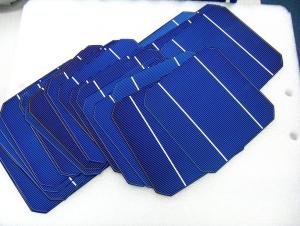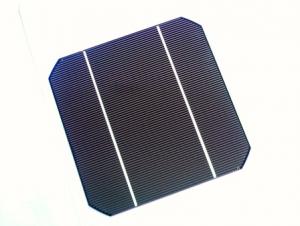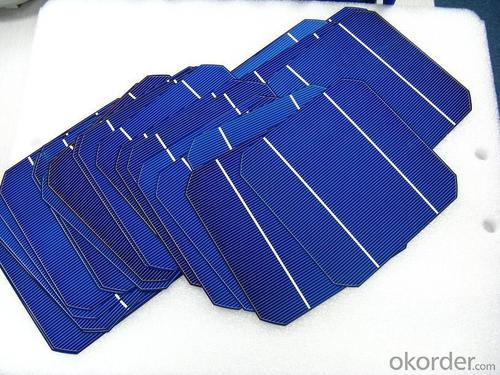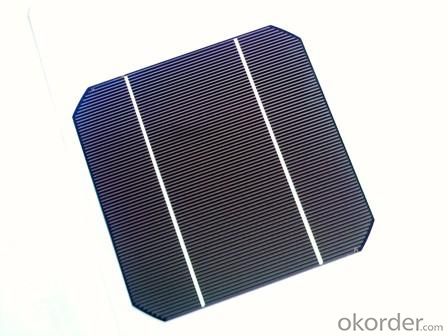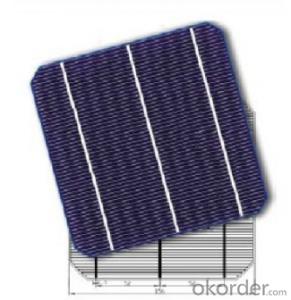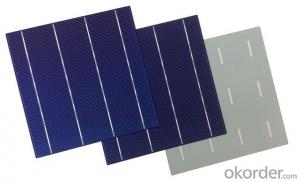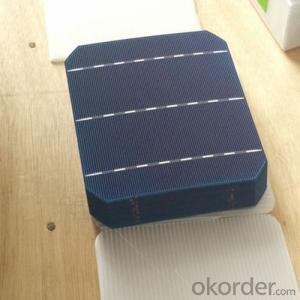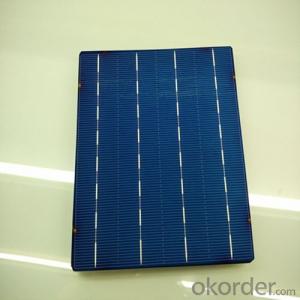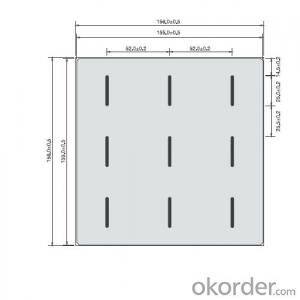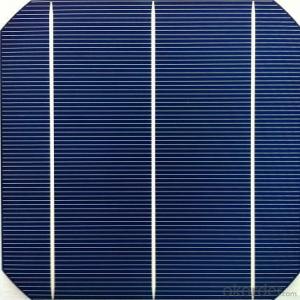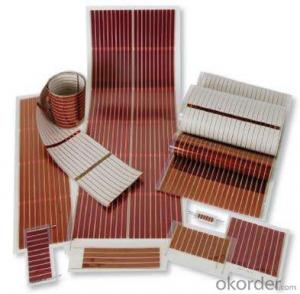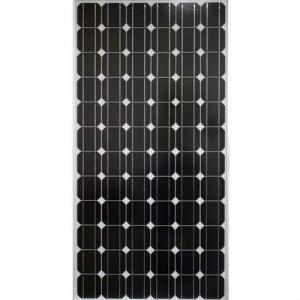2016 Hot Sale Mono Solar Cells 2BB/3BB 156 mm X 156 mm Products
- Loading Port:
- Ningbo
- Payment Terms:
- TT or LC
- Min Order Qty:
- 4200 watt
- Supply Capability:
- 600000 watt/month
OKorder Service Pledge
OKorder Financial Service
You Might Also Like
Specifications of Mono Solar Cells
Format : 156 mm × 156 mm ± 0.5 mm
Thickness: 210 μm ±40 μm
Front (-) : 1.5mm bus bars (silver),blue anti-reflection coating (silicon nitride)
Back (+) : 2.5mm wide soldering pads (silver) back surface field (aluminium)
Electrical Characteristic of Mono Solar Cells
Efficiency (%) | Pmpp (W) | Umpp (V) | Impp (A) | Uoc (V) | Isc (A) | FF (%) |
18.35 | 4.384 | 0.526 | 8.333 | 0.63 | 8.877 | 78.39% |
18.20 | 4.349 | 0.526 | 8.263 | 0.63 | 8.789 | 78.54% |
18.05 | 4.313 | 0.525 | 8.216 | 0.63 | 8.741 | 78.32% |
17.90 | 4.277 | 0.524 | 8.161 | 0.629 | 8.713 | 78.04% |
17.75 | 4.241 | 0.523 | 8.116 | 0.629 | 8.678 | 77.70% |
17.60 | 4.206 | 0.521 | 8.073 | 0.628 | 8.657 | 77.36% |
17.45 | 4.170 | 0.519 | 8.039 | 0.628 | 8.633 | 76.92% |
17.30 | 4.134 | 0.517 | 8.004 | 0.626 | 8.622 | 76.59% |
17.15 | 4.098 | 0.516 | 7.938 | 0.625 | 8.537 | 76.80% |
17.00 | 4.062 | 0.512 | 7.933 | 0.625 | 8.531 | 76.18% |
16.75 | 4.002 | 0.511 | 7.828 | 0.625 | 8.499 | 75.34% |
16.50 | 3.943 | 0.510 | 7.731 | 0.625 | 8.484 | 74.36% |
Advantage of Mono Solar Cells
1. High efficiency and High power.
2. Long-term electrical stability.
3. Lowest price and Fastest delivery.
4. Good quality and best service.
5. Bulk supply
6. Trusted Warranty
7. Big Sale
8. More than 25 years on the lifetime.
Usage and Applications of Mono Solar Cells
Solar cells are often electrically connected and encapsulated as a module.
Photovoltaic modules often have a sheet of glass on the front (sun up) side, allowing light to pass while protecting the semiconductor wafers from abrasion and impact due to wind-driven debris, rain, hail, etc.
Solar cells are also usually connected in series in modules, creating an additive voltage.
Connecting cells in parallel will yield a higher current;our solar cells have passed IEC Certification. With high quality and stable quality.
Our Cells can greatly improve the performance of Solar Modules.
Packaging & Delivery of Mono Solar Cells
Carton Box Package and Deliver by air. It should be noticed that it should be avoid of water, sunshine and moist.
Factory Picture of Mono Solar Cells
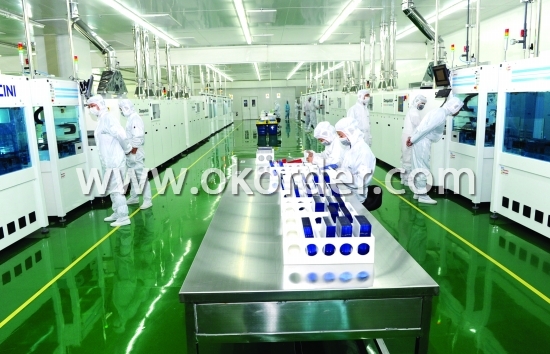
Package Picture of Mono Solar Cells
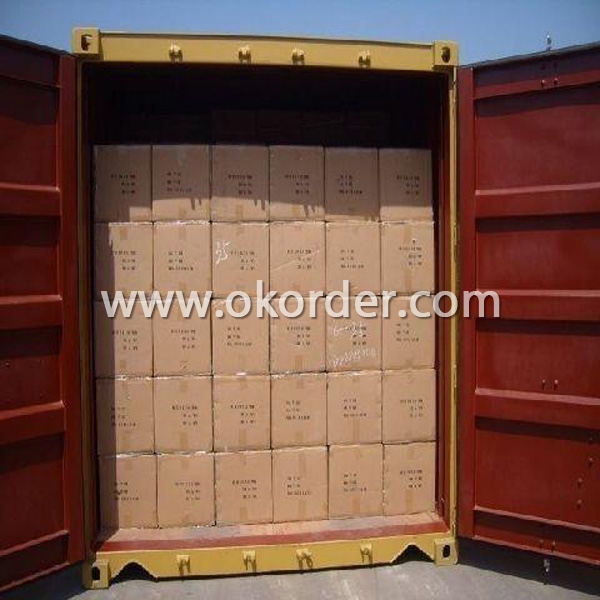
In the long term, despite the current cost of a single crystal is high, but the cost of the single crystal pulling and other non-silicon costs will gradually close to the ingot and other non-cost polycrystalline silicon in future, therefore the downside of mono solar cells’ cost is greater than polycrystalline. At the same time the existing P-type cell conversion efficiency has been gradually facing a bottleneck, while the new N-type monocrystalline cells (conversion efficiency to 22% to 24%) is already in production, costs and wait until the technology to further breakthroughs, is expected to gradually spread. So the future is expected to gradually increase the amount of a single crystal production, the production of photovoltaic silicon cells account for world dominance.
Polycrystalline silicon solar cell production analysis
According to statistics, 2003--2012 global polysilicon solar cell production increased year by year, from 2003 to 2012 grew 467MW 17292MW, the annual compound growth rate of more than 40% from the market share of various types of solar cells see 2003 - 2005 period the proportion of polycrystalline silicon cells decreased from 63-57% in 2006 - in 2012 it remained stable at 45% - 50%. The first half of 2013, global polysilicon solar cell production reached 9432MW.
Polycrystalline silicon solar cell market outlook
The first half of 2013, global polysilicon production reached 100,000 tons, crystalline silicon solar cell production of 18GW, polycrystalline silicon consumes about 11 million tons, because the downstream PV companies continue to digest inventory, the polysilicon market supply and demand balance. From a market share point of view, 2012 - May 2013, the market share is still slightly higher than the polycrystalline silicon solar cell silicon solar cells. This highlights the current status of polycrystalline silicon photovoltaic cell technology market is still one of the two major technology firms.
But according to the performance of domestic companies since 2012, mono solar cells 2BB/3BB technology is better than the overall performance of the company polysilicon companies. The current global PV market has not yet fully grown; mono solar cells 2BB/3BB and polycrystalline technology has living space. Short and medium term, polysilicon will remain relatively dominant. From the long-term trend, mono solar cells 2BB/3BB will be able to share half of the market space at least.
- Q: Can solar cells be used in sports stadiums?
- Yes, solar cells can be used in sports stadiums. They can be installed on the roof or integrated into the design of the stadium to capture solar energy and convert it into electricity. This renewable energy source can help power lighting, scoreboards, and other electrical systems, making sports stadiums more sustainable and reducing their carbon footprint.
- Q: What is the impact of hailstorms on solar cells?
- Hailstorms can have a detrimental impact on solar cells. The physical impact of hailstones can cause cracks or shattering of the solar panels, leading to reduced efficiency or complete failure of the cells. Additionally, the protective layers of the solar panels can be damaged, making them more susceptible to moisture intrusion and corrosion. Overall, hailstorms pose a significant risk to the durability and performance of solar cells.
- Q: Can solar cells be used in boats or marine applications?
- Yes, solar cells can be used in boats or marine applications. Solar panels can be installed on boats to generate electricity by harnessing the power of the sun. This renewable energy source can be used to power various systems onboard such as navigation equipment, lighting, communication devices, and even charging batteries. Solar cells are a sustainable and efficient solution for boats and marine applications as they provide a clean and quiet source of power, reducing the reliance on fossil fuels and minimizing environmental impact.
- Q: Are solar cells affected by electromagnetic interference?
- Yes, solar cells can be affected by electromagnetic interference (EMI). EMI refers to the disturbance caused by electromagnetic radiation on electronic devices, including solar cells. The interference can lead to reduced efficiency and performance of the solar cells. Shielding techniques and proper grounding can be employed to mitigate the impact of EMI on solar cells.
- Q: Can solar cells be used to power remote locations?
- Yes, solar cells can be used to power remote locations. Solar cells, also known as photovoltaic cells, convert sunlight into electricity, making them an ideal solution for off-grid and isolated areas where traditional power sources are not available or feasible to install. Solar panels can be easily set up in remote locations to harness solar energy and generate electricity, providing a reliable and sustainable power source for various applications such as lighting, communication systems, water pumping, and even small-scale industrial processes.
- Q: How do solar cells impact carbon emissions?
- Solar cells have a significant positive impact on carbon emissions as they generate electricity without burning fossil fuels, thus reducing reliance on carbon-intensive energy sources. By harnessing the sun's energy, solar cells help minimize greenhouse gas emissions, combatting climate change and promoting a cleaner and more sustainable energy future.
- Q: How do solar cells handle electromagnetic radiation?
- Solar cells are designed to handle electromagnetic radiation by converting it into usable electrical energy. The materials within the solar cells absorb photons from the sunlight, which in turn generates an electric current. This process effectively harnesses the energy from the electromagnetic radiation and allows solar cells to produce clean and renewable electricity.
- Q: What is the internal structure of solar panels
- EVA used to bond fixed glass and power generation body (such as battery), transparent EVA material directly affect the quality of the component life, exposure to air in the EVA easy to aging yellow, thus affecting the component's light transmittance, thus
- Q: Can solar cells be used for powering remote research stations in Antarctica?
- Yes, solar cells can be used for powering remote research stations in Antarctica. They provide a reliable and sustainable source of energy in a region where sunlight is available for a significant portion of the year. Solar panels can be installed to capture sunlight and convert it into electricity, allowing for the operation of essential equipment and facilities in these remote locations without relying on traditional fossil fuel-based generators.
- Q: Can solar cells be used in telecommunications?
- Yes, solar cells can be used in telecommunications. They can power various telecommunication devices such as cell phones, radio transmitters, satellites, and remote communication systems, especially in areas with limited access to electricity grids. Solar energy can be harnessed to charge batteries or directly power these devices, providing a reliable and sustainable source of energy for telecommunications.
1. Manufacturer Overview
| Location | Zhejiang, China |
| Year Established | 2008 |
| Annual Output Value | Above US$ 320 Million |
| Main Markets | Australia; Asia; South East Asia; South America; North America; Europe; Africa |
| Company Certifications | ISO 9001:2008; CE; TUV; UL |
2. Manufacturer Certificates
| a) Certification Name | |
| Range | |
| Reference | |
| Validity Period |
3. Manufacturer Capability
| a) Trade Capacity | |
| Nearest Port | Ningbo, China |
| Export Percentage | 45% - 50% |
| No.of Employees in Trade Department | 200-300 People |
| Language Spoken: | English; Chinese |
| b) Factory Information | |
| Factory Size: | Above 10,000 Square meter |
| No. of Production Lines | 8 |
| Contract Manufacturing | OEM Service Offered; Design Service Offered |
| Product Price Range | Average |
Send your message to us
2016 Hot Sale Mono Solar Cells 2BB/3BB 156 mm X 156 mm Products
- Loading Port:
- Ningbo
- Payment Terms:
- TT or LC
- Min Order Qty:
- 4200 watt
- Supply Capability:
- 600000 watt/month
OKorder Service Pledge
OKorder Financial Service
Similar products
Hot products
Hot Searches
Related keywords
